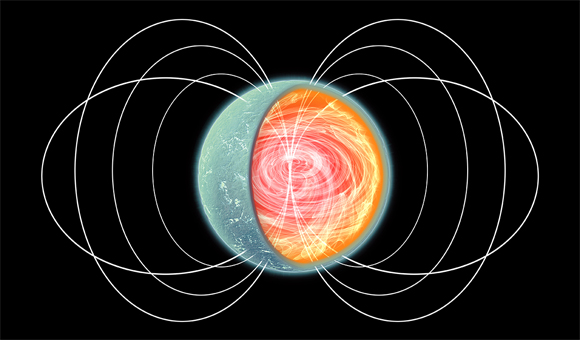
Never let it be said that stars don't have style: when a massive star comes to the end of its life it doesn't quietly burn out like a dying candle. Instead, it goes out with a bang, or rather an explosion that outshines almost everything else in the Universe! This explosion is called a supernova, and when this happens, the star is torn apart, throwing material into space. But something is left behind - a 'neutron star' - the remaining core of a massive star once it has exploded.
This picture might look like a jawbreaker that's been dipped in dental floss, but it actually shows an artist's impression of a very exotic type of neutron star called a "magnetar".
Magnetars are some of the most extreme objects known in the Universe. They are a very small and ultra-compact type of neutron star that erupt randomly with bursts of powerful high-energy flares. These stars were given their name because they are very strong magnets. You've probably played with magnets in school. Each magnets is surrounded by an invisible force field, called a "magnetic field".
Magnetars have notoriously strong magnetic fields - the strongest in the entire Universe, in fact! Well, except for this one. This picture shows "SGR 0418", a magnetar that doesn't fit the mould. It has a much weaker magnetic field on its surface than any other star of its kind. What makes this really puzzling is that it raises the question: where does the energy come from to power its dramatic high-energy flares? It is thought to come from the strong magnetic field. But this theory doesn't work for SGR 0418! SGR 0418 appears to be an oddity amongst oddities! Astronomers are puzzled but think that there is a much stronger magnetic field underneath the surface of SGR 0418.
Cool fact: Guess what? The Earth is a giant magnet! Like magnetars, Earth has a magnetic field extending from the North Pole to the South Pole (although nowhere near as strong!) We should be very thankful for Earth's magnetic field, it protects us from harmful radiation sent from the Sun and it causes the beautiful Northern Lights!
Watch the video podcast
Do you want to learn more about this topic?
Visit the Chandra field guide or send us your questions in an email: cxcpub@cfa.harvard.edu
In cooperation with Space Scoop: Bringing news from across the Universe to children all around the world. Universe Awareness and the Chandra X-ray Observatory
| Children & Online Privacy |



